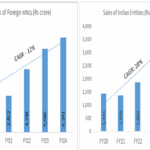- “More than 19% of Indian adult population today suffers from chronic pain of some kind, with prevalence being higher in females (25%)
- More and more young people have also begun to suffer from chronic pain due to unhealthy, physically inactive lifestyle
- For most cases of chronic pain, less invasive and non-surgical interventions are better alternatives compared to open surgical methods”
Bengaluru/Chandigarh, September 15, 2021:
Chronic pain – defined as any persistent pain lasting more than three months – is rapidly emerging as a significant healthcare challenge in India that is going to extract a heavy toll on the social and health infrastructure of the country in the coming years. This was said by pain specialists of Interventional Pain and Spine Centre (IPSC), a chain of single-specialty centres offering state-of-the-art spine care and chronic pain management with less invasive techniques.
More than 19% of Indian adult population today suffers from chronic pain of some kind, with prevalence being higher in females (25%). The prevalence increases steeply beyond the age of 65 years, according to a survey.[1] This may be the tip of the iceberg as Indians usually understate their health issues and would rather not reveal their pain problems to others.
Said Dr. (Maj) Pankaj N Surange, Managing Director and CEO, IPSC India: “Chronic pain will take a huge social and economic toll in the next two decades with significant spending on surgical treatment and hospitalization. It has a serious impact on work, with increasing loss of workdays associated with chronic pain, especially low back pain. It also interferes with one’s social life, daily routine like walking or exercising, taking care of oneself and the family, and leading an independent lifestyle. Many patients start suffering from depression, anxiety and sleeping problems. Chronic pain does not occur in isolation. There are often a variety of mental and physical health problems behind it.”
Talking about the increasing incidence of chronic pain in India, Dr. (Maj) Pankaj N Surange said: “There has been a gradual rise in the number of older people in the society due to rising life expectancy. This is driving an increase in the incidence of chronic pain. The younger population too is getting affected, mainly due to leading a sedentary and physically inactive lifestyle. The commonest types of chronic pain faced by people include spinal pain, joint pain and migraine. Arthritis, degenerative conditions of the spine, and cancer are the most common contributors to chronic pain.”
Said Dr. Swati Bhat, Consultant Interventional Spine & Cancer Pain, IPSC India: “In the West, pain medicine has been a super-specialty for the last three to four decades. In India, it is only 15-20 years old. Several hospitals in the country now offer pain management as a separate discipline. Till five years ago, Western protocols were being used to manage Indian patients of chronic pain. However, now India-specific protocols have been developed for better outcomes.”
Talking about the treatment of chronic pain, Dr. Swati Bhat said: “For most cases of chronic pain, less invasive and target-specific interventions (called interventional pain management) are better alternatives compared to open surgical methods, as these involve less risk and trauma to patient. They are also much safer and don’t require hospital admission. Since most of these non-surgical procedures can be done in a day care setting, they cost almost half compared to conventional surgeries. Patients can go back home the same day. Early interventions not only relieve pain, but also reduce morbidity and improve quality of life. We currently have Indian protocols for all interventional procedures for pain management, which is a big step forward.”
Said Dr. Om Prakash Gupta, Senior Consultant, IPSC India, who is a well-known orthopedic, joint replacement and spine surgeon: “In interventional pain management, patients suffering from back pain, slipped disc, disc bulge, sciatica etc. are treated with less invasive techniques like ozone discectomy, percutaneous disc decompression and endoscopic discectomy where a small scope is inserted to remove the herniated portion of the disc. Patients suffering from arthritis of the joints are managed with regenerative interventions in their early stages to prevent progression. Pain in advanced arthritis of knee, shoulder, hip and spinal joints is managed with radiofrequency procedures. Nerve pain, including neuralgia and neuropathic pain, is managed with medication and neurolytic procedures. All these procedures are done under local anesthesia and patients are discharged the same day.”
A 2018 survey of 20,000 patients of back pain from Indian metro cities estimated that 46% of Bengaluru’s population in the younger age group suffers from spinal problems. This is among the highest incidence in the country. About 43% of patients neglect their pain for more than 7 weeks, leading to delayed treatment and increased risk of surgery.
Added Dr. (Maj) Pankaj N Surange: “With better understanding of chronic pain and technological advancement, pain physicians can now control chronic pain adequately and cure it in most cases. However, it is the responsibility of the doctors to treat acute stages of pain promptly to prevent patients from sliding into chronic pain.”
healthysoch







